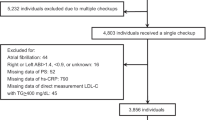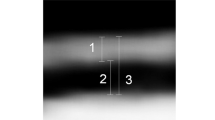Abstract
Carotid artery intima-media thickness (IMT) has been used as a surrogate marker of atherosclerosis and is related to cardiovascular risk. Indices of arterial stiffness are also associated with cardiovascular risk and atherosclerosis. The aim of this study was to assess the prognostic value of the combination of surrogate markers of cardiovascular disease measured non-invasively in subjects without cardiovascular disease. In this cross-sectional study, 81 young and middle aged males (39.2±6.3 years) without evidence of overt cardiovascular disease or diabetes mellitus were enrolled. High-resolution B-mode ultrasonography and pulse wave analysis were used to measure carotid artery IMT and augmentation index (AI), a measure of arterial stiffness. Framingham risk score (FRS) was used as an estimate of the risk for development of cardiovascular disease. Regional differences were observed in the carotid arteries’ IMT regarding their relationship with FRS: combined (average from all sites) IMT and IMT in the carotid bulb (CB), but not in the common (CC) and internal carotid artery (IC), and AI showed significant increases of FRS by their tertiles. However, subjects with both AI and IMT at any site in the highest tertile (AI>15%, CC>0.65 mm, CB>0.8 mm, IC>0.65 mm) had an increased FRS compared to subjects with one or none of these parameters in the highest tertile. In conclusion, young and middle-aged men without overt cardiovascular disease with both high IMT and AI are in high cardiovascular risk, as assessed by FRS. Epidemiological studies are needed to further validate this combination.
This is a preview of subscription content, access via your institution
Access options
Subscribe to this journal
Receive 12 digital issues and online access to articles
$119.00 per year
only $9.92 per issue
Buy this article
- Purchase on Springer Link
- Instant access to full article PDF
Prices may be subject to local taxes which are calculated during checkout


Similar content being viewed by others
References
Stary HC . Evolution and progression of atherosclerotic lesions in coronary arteries of children and young adults. Arteriosclerosis 1989; 9: 119–132.
Kieltyka L, Urbina EM, Tang R, Bond MG, Srinivasan SR, Berenson GS . Framingham risk score is related to carotid artery intima-media thickness in both white and black young adults: the Bogalusa Heart Study. Atherosclerosis 2003; 170: 125–130.
Urbina EM, Srinivasan SR, Tang R, Bond MG, Kieltyka L, Berenson GS . Impact of multiple coronary risk factors on the intima-media thickness of different segments of carotid artery in healthy young adults (The Bogalusa Heart Study). Am J Cardiol 2002; 90: 953–958.
Wikstrand J, Wiklund O . Frontiers in cardiovascular science: quantitative measurements of atherosclerotic manifestations in humans. Arterioscler Thromb 1992; 12: 114–119.
Grobbee DE, Bots ML . Carotid artery media thickness as an indicator of generalized atherosclerosis. J Intern Med 1994; 236: 567–573.
Hulthe J, Wikstrand J, Emanuelsson H, Wiklund O, de Feyet PJ, Wendelhag I . Atherosclerotic changes in the carotid artery bulb as measured by B-mode ultrasound are associated with the extent of coronary atherosclerosis. Stroke 1997; 28: 1189–1194.
Khoury Z, Schwartz R, Gottlieb S, Chenzbraun A, Stern S, Keren A . Relation of coronary artery disease to atherosclerotic disease in the aorta, carotid, and femoral arteries evaluated by ultrasound. Am J Cardiol 1997; 80: 1429–1433.
Lekakis JP, Papamichael CM, Cimponeriu AT, Stamatelopoulos KS, Papaioannou TG, Kanakakis J et al. Atherosclerotic changes of extracoronary arteries are associated with the extent of coronary atherosclerosis. Am J Cardiol 2000; 84: 949–952.
Mancini GB, Dahlof B, Diez J . Surrogate markers for cardiovascular disease. Structural markers. Circulation 2004; 109 (Suppl IV): IV22–IV30.
Chambless LE, Heiss G, Folsom AR, Rosamond W, Szklo M, Sharrett AR et al. Association of coronary heart disease incidence with carotid arterial wall thickness and major risk factors: The Atherosclerosis Risk in Communities (ARIC) Study, 1987–1993. Am J Epidemiol 1997; 146: 483–494.
O’Rourke MF, Pauca A, Jiang XJ . Pulse wave analysis. Br J Clin Pharmacol 2001; 51: 507–522.
Kelly RP, Millaseau SC, Ritter JM, Chowienczyk PJ . Vasoactive drugs influence aortic augmentation index independently of pulse-wave velocity in healthy men. Hypertension 2001; 37: 1429–1433.
Nurnberger J, Keflioglu-Scheiber A, Opazo Saez AM, Wenzel RR, Philipp T, Schafers RF . Augmentation index is associated with cardiovascular risk. J Hypertens 2002; 20: 2407–2414.
Weber TJ, Auer J, O’Rourke MF, Kvas E, Lassnig E, Berent R et al. Arterial stiffness, wave reflections, and the risk of coronary artery disease. Circulation 2004; 109: 184–189.
Cohn JN, Quyyumi AA, Hollenberg NK, Jamerson KA . Surrogate markers for cardiovascular disease. Functional markers. Circulation 2004; 109 (Suppl IV): IV31–46.
Expert Panel on Detection, Detection, Evaluation, and Treatment of High Blood Cholesterol in Adults. Executive summary of the third report of the National Cholesterol Education Program (NCEP) expert panel on detection, evaluation, and treatment of high blood cholesterol in adults (Adult Treatment Panel III). JAMA 2001; 285: 2486–2497.
Wilkinson IB, MacCallum H, Flint L, Cockcroft JR, Newby DE, Webb DJ . The influence of heart rate on augmentation index and central arterial pressure in humans. J Physiol 2000; 525: 363–370.
De Groot E, Joukema WJ, Montauban van Swijndregi AD, Zwinderman AH, Ackerstaff RG, van der Steen AF et al. B-mode ultrasound assessment of pravastatin treatment effect on carotid and femoral artery walls and its correlations with coronary arteriographic findings: a report of the Regression Growth Evaluation Statin Study (REGRESS). J Am Coll Cardiol 1998; 31: 1561–1567.
Koboyashi K, Akishira M, Yu W, Hashimoto M, Ohni M, Toba K . Interrelationship between non-invasive measurements of atherosclerosis: flow-mediated dilation of brachial artery, carotid intima-media thickness and pulse wave velocity. Atherosclerosis 2004; 173: 13–18.
Wilkinson IB, Fuchs SA, Jansen IM, Spratt JC, Murray GD, Cockroft JR et al. Reproducibility of pulse wave velocity and augmentation index measured by pulse wave analysis. J Hypertens 1998; 16: 2079–2084.
Filipovsky J, Svobodova V, Pecen L . Reproducibility of radial pulse wave analysis in healthy subjects. J Hypertens 2000; 18: 1033–1040.
Papaioannou TG, Stamatelopoulos KS, Gialafos ES, Vlachopoulos C, Karatzis E, Nanas J et al. Monitoring of arterial stiffness indices by applanation tonometry and pulse pressure: reproducibility at low blood pressures. J Clin Monit Comput 2004; 18: 137–144.
Bramwell JC, Hill AV . Velocity of transmission of the pulse and elasticity of arteries. Lancet 1922; 1: 891–892.
Merillon JP, Lebras Y, Chastre J, Lerallut JF, Motte G, Fontenier G et al. Forward and backward waves in the arterial system, their relationship to pressure waveforms. Eur Heart J 1983; 4: G13–G20.
Glagov S, Zarins C, Giddens DP, Ku DN . Hemodynamics and atherosclerosis: insights and perspectives gained from studies of human arteries. Arch Pathol Lab Medi 1988; 112: 1018–1031.
Author information
Authors and Affiliations
Corresponding author
Rights and permissions
About this article
Cite this article
Stamatelopoulos, K., Kalpakos, D., Protogerou, A. et al. The combined effect of augmentation index and carotid intima-media thickness on cardiovascular risk in young and middle-aged men without cardiovascular disease. J Hum Hypertens 20, 273–279 (2006). https://doi.org/10.1038/sj.jhh.1001978
Received:
Revised:
Accepted:
Published:
Issue Date:
DOI: https://doi.org/10.1038/sj.jhh.1001978
Keywords
This article is cited by
-
Aortic haemodynamics: the effects of habitual endurance exercise, age and muscle sympathetic vasomotor outflow in healthy men
European Journal of Applied Physiology (2022)
-
When the arteries get tough, the tougher do not get going
Hypertension Research (2011)
-
Low-sodium DASH reduces oxidative stress and improves vascular function in salt-sensitive humans
Journal of Human Hypertension (2009)
-
The Effect of Heart Rate on Wave Reflections May Be Determined by the Level of Aortic Stiffness: Clinical and Technical Implications
American Journal of Hypertension (2008)
-
Reactive oxygen species production by circulating monocytes: insights from pathophysiology to clinical hypertension
Journal of Human Hypertension (2006)



